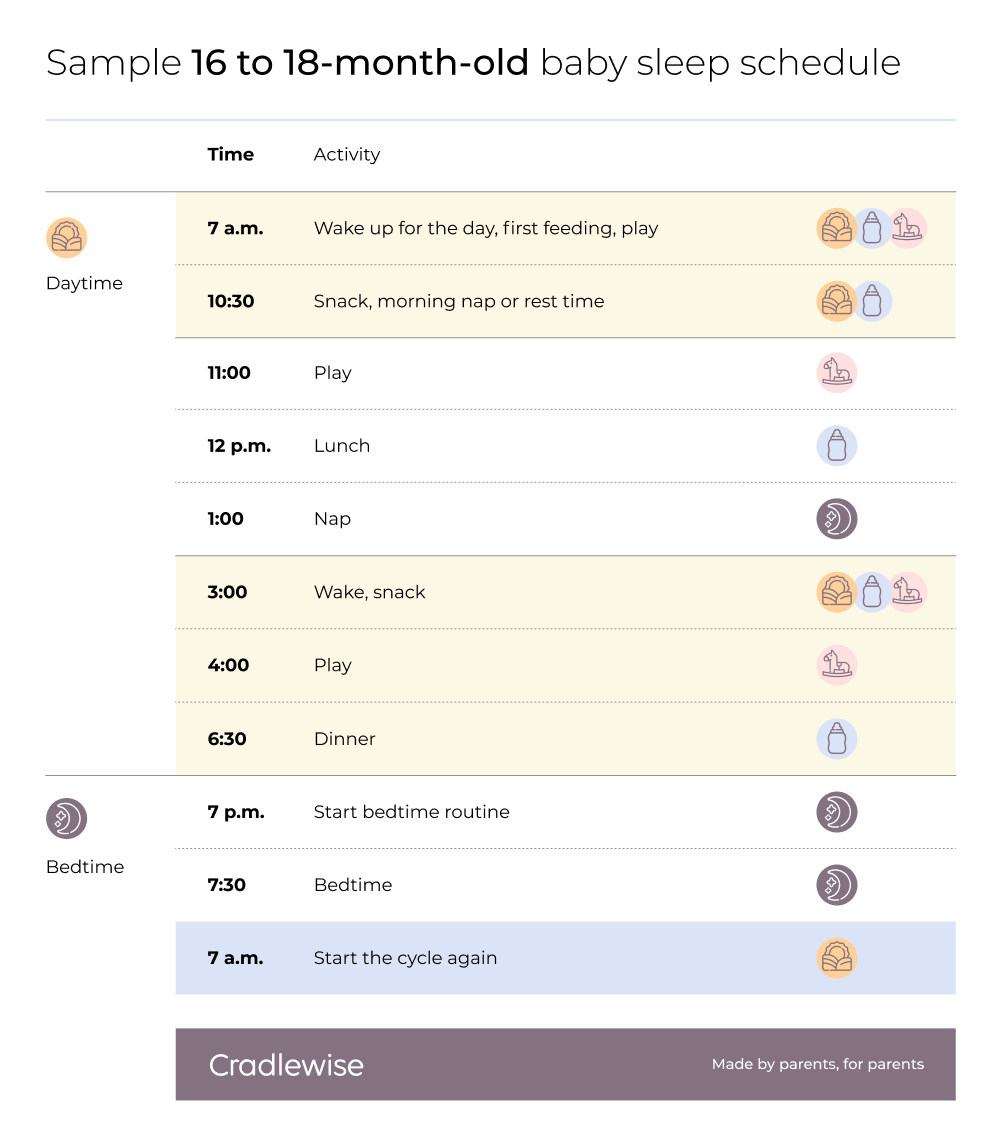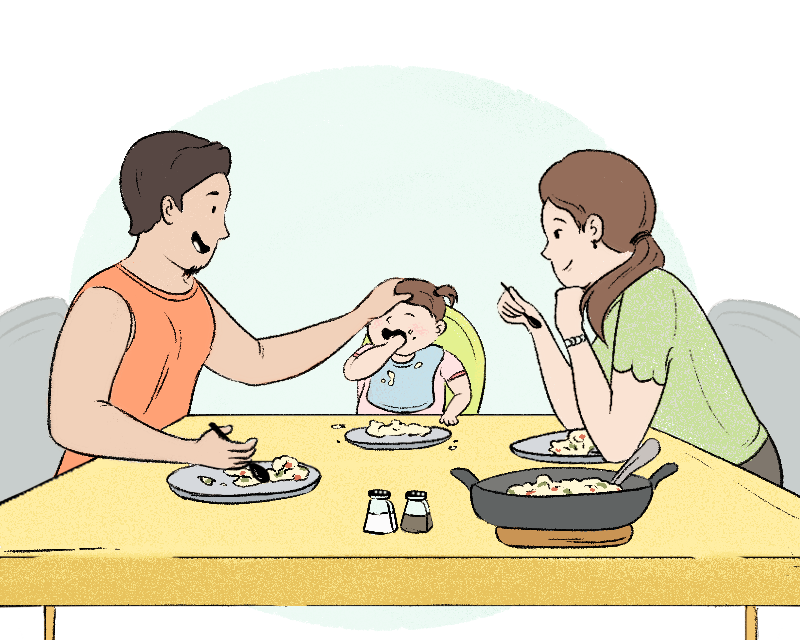
Night sleep
11 hours

Daytime naps
2-3 hours

Total sleep
11-14 hours
From 16 to 18 months, your baby is firmly in toddler territory. While not all toddlers’ sleep will look the same, of course, there are some changes you can expect from your new, probably very active toddler.
For starters, most toddlers in this range will start the transition from two naps a day to just one. That can definitely change both your routine at home as well as your sleep routine.
Going from two naps a day to one can be an adjustment for some children—and it’s okay to take it slow.
Here’s more about what’s happening with your 16- to 18-month-old in terms of development, sleep milestones, nutrition needs, and more.
16- to 18-month-old baby milestones for sleep
Around 16 to 18 months of age, many babies start transitioning to one afternoon nap instead of taking a morning and afternoon nap.
Not all toddlers this age will be ready to drop their morning nap, of course, so if yours is just not there yet, don’t force it! Sleep is one of the most important aspects of your toddler’s life right now—it’s when vital development and brain growth happen, so prioritizing sleep is crucial.
Your toddler may move towards just one afternoon nap closer to 18 months or even approaching their second birthday. Signs they are ready for just one nap might include:
- Having a harder time falling asleep at night after two naps
- Not falling asleep during one of their naps
- Consistently resisting their morning nap
Every child will put up a resistance to nap time once in a while, so it’s important not to drop the nap too early.
A nap strike once a week is probably just a toddler being a toddler. But a nap strike every day for three weeks straight? Well, that might be a sign it’s time to drop the morning nap.
Once the nap transition does happen, the second big milestone is that your toddler will have a much longer wake window (the period of alert play between daytime naps), perhaps as long as 6 hours.
That means that both of you might have to adjust to some new routines—including lots of opportunities for more playtime together!
What’s going on in your baby’s brain?

While you may have just gotten used to having a baby on your hip, this stage of toddlerhood is all about slowly starting to develop independence.
From 16-18 months old—and especially as they approach their second birthday—your toddler will probably start to want you close, but not too close.
That means that they might want to try new skills, like climbing the playground, running away, or trying to get into that one cupboard they know you don’t want them to, all while throwing a glance or two your way to make sure you’re still looking. Toddlers: always keeping you on your toes, right?
According to the Centers for Disease Control and Prevention (CDC), some of the new milestones you might see by 18 months include:
- “Helping” you get them dressed, such as lifting an arm or leg up
- “Reading” books with you and without you
- Playing with simple toys, like a ball or rolling a car
- Saying 3-5 words
- Copying you or another caregiver
- Using a spoon (or at least trying to!)
- Walking and climbing
How much should a 16- to 18-month-old sleep?
Throughout toddlerhood, your child’s total daily sleep needs stay about the same, although the number of naps they take every day might change.
According to the CDC, your 16- to 18-month-old should get a total of around 11 to 14 hours of sleep every day, which includes naps.
- Total hours of sleep: 11 to 14 hours
- Wake windows: 5 to 6 hours
- Number of naps: 1 or 2
Sample 16- to 18-month-old sleep schedule
There’s no one-size-fits-all sleep schedule for all 16-18 month-olds, and you might actually see a big difference between a 16-month-old who hasn’t dropped their second nap and an 18-month-old who has. During this transitional phase in your toddler’s sleep habits, it’s more important than ever to pay attention to your child’s individual sleep cues.
Looking for a sample sleep schedule for your 16- to 18-month-old? Here’s a good place to start.


16- to 18-month-old feeding tips

As a full-fledged toddler, your child’s calories and nutrition will now come from solid foods instead of liquids, just like adults.
However, if you’re nursing, you can continue to nurse or provide your child with breast milk for as long as you would like.
The World Health Organization does say children can continue nursing for as long as mutually desired by both parent and child until the age of 2.
What should you feed a 16- to 18-month-old toddler? At this age, toddlers can eat anything that the entire family is eating.
In fact, bringing the whole family together at mealtime has many benefits beyond nutrition alone.
For example, the American College of Pediatricians explains that kids who eat family meals have healthier habits later in life, including lower rates of disordered eating and depression and higher rates of healthy weight.
You may need to make safety allowances when feeding a toddler, such as avoiding major choking hazards—including hot dogs, whole grapes, and popcorn—and cutting all meat and raw vegetables, but in general, gather ‘round for meals you can all enjoy.
- How much should a 16- to 18-month-old eat? According to the American Academy of Pediatrics (AAP), a child aged one to three years requires approximately 40 calories per inch of height, with half of those calories coming from fat.
For instance, if a toddler is 32 inches tall, they would ideally consume around 1,300 calories per day. Nevertheless, this quantity differs based on the child’s individual physique and level of physical activity.
- How much should a 16- to 18-month-old weigh? By 18 months, the average toddler is around 24-25 pounds and 30-32 inches tall, says AAP.
- How often should a 16- to 18-month-old eat? Like adults, the AAP says that toddlers should be offered 3 meals and 2 snacks a day.
However, a hallmark of toddler eating is inconsistency: that means that it’s very normal for your toddler to be hungrier some days more than others, or to eat a lot at one meal and not as much the next.
Avoid forcing your child to eat when they aren’t hungry; instead, encourage them to recognize and listen to their own hunger cues. - Tip: Stick to full-fat foods at this age. The AAP recommends that toddlers eat full-fat dairy items, including whole milk and full-fat yogurt and cheese to help them reach their recommended levels.
- Tip: Hold the juice. While the AAP recommends that whole fruits be given over fruit juice whenever possible because it has more nutritional value, like fiber and extra vitamins, if you do decide to give your child juice, stick to no more than 1 cup of juice per day from ages 1-6 years old.
How to help support your baby’s sleep from 16-18 months

Keep the following helpful sleep tips in mind:
Don’t panic if you hit sleep regression.
Don’t panic if you hit sleep regression.
In general, the older your toddler gets, the more you can count on uninterrupted nights of sleep. However, when your toddler goes through a big growth spurt or developmental milestone, you might encounter a sleep regression, in particular a 15-month-old sleep regression or a 18-month sleep regression. A sleep regression simply means your toddler might experience some “bad” sleep behaviors, such as waking up a lot at night, not wanting to go to sleep, more crying, or resisting a nap. Be assured that these are normal, and your child will eventually go back to their normal sleep routine.
Be selective about screen time.
Be selective about screen time.
It can be difficult to completely avoid screens for toddlers—especially on those nap strike days!—but the AAP officially recommends that toddlers under the age of 18 months have no screen time at all (outside of video chatting with loved ones). After your toddler hits 18 months old, the AAP recommends choosing “high-quality programming/apps” and always using screens with your child, never letting them use them alone. (I agree with you that it sounds like the AAP has never actually spent a full day alone with the toddler, but remember, I’m just the messenger here!)
Consider a gentle form of sleep training.
Consider a gentle form of sleep training.
The toddler age is a time of budding independence for your child, so it’s a great time to introduce a more independent sleep routine if you have not already. For instance, the chair method of sleep training is a gentle one that gradually helps teach your toddler to fall asleep without you. The method is simple: you sit on a chair next to your child as they fall asleep and each night (or every other night, depending on how long it takes), you move the chair further away from them. By the time you’re out of their room in your chair, you can safely say they will be able to fall asleep without you.
Adjust bedtimes as needed.
Adjust bedtimes as needed.
If your toddler is in the process of transitioning from two naps to one or experiences that 15- or 18-month-old sleep regression, don’t be afraid to move up bedtime if you need to. It’s always best to follow your toddler’s sleep cues and put them to bed before they reach the point of being overtired. So while we preach consistency here, that might look like consistency with your sleep routine and not always the same bedtime during periods of transition. The most important thing is that your toddler is getting the sleep that you both need!
More posts you might like:
- 19- to 21-month-old toddler sleep guide
- 22- to 24-month-old toddler sleep guide
- What should baby wear to sleep?
- Baby sounds during sleep and their meaning
- How to prep your baby (and you!) for the first day of daycare
Sources:
- The one-nap transition. 2023. Cradlewise. How do you know when a baby is ready to drop to one nap? 6 tell-tale signs.
- 18-month-old milestones. Centers for Disease Control and Prevention. Important Milestones: Your Baby By Eighteen Months.
- Sleep recommendations for infants and toddlers. 2023. Centers for Disease Control and Prevention. How Much Sleep Do I Need?
- Breastmilk recommendations. 2023. Centers for Disease Control and Prevention. Key Breastfeeding Indicators.
- Family mealtime. 2021. American College of Pediatricians. The Benefits of the Family Table.
- Feeding your one-year-old. 2022. Centers for Disease Control and Prevention. Feeding & Nutrition Tips: Your 1-Year-Old.
- Toddler nutrition. 2021. American Academy of Pediatrics. Toddler Food and Feeding.
- Toddler hydration. 2020. American Academy of Pediatrics. Choose Water for Healthy Hydration.
- Average height and weights for toddlers. 2009. HealthyChildren.org. Physical Appearance and Growth: Your 1-Year-Old.
- Feeding tips for toddlers. 2022. HealthyChildren.org. Feeding & Nutrition Tips: Your 2-Year-Old.
- Sleep regressions. 2023. Sleep Foundation. 18-Month Infant Sleep Regression.
- Screentime recommendations for toddlers. 2022. American Academy of Pediatrics. Where We Stand: Screen Time.
You may also like




